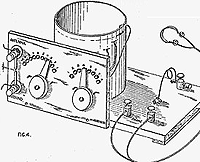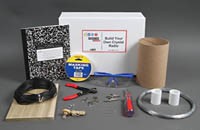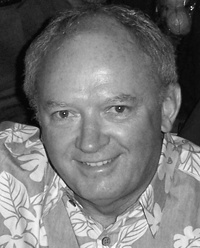The Call of the Crystal Radio
Ask an engineer if she has ever built a crystal radio, and chances are you will get a story—one with all the makings of a classic when it comes to garage engineering and adolescence. Students often build a crystal radio as a first step in engineering and electronics—or as a middle school science fair project. If they have questions or need assistance troubleshooting their "set," they may be lucky enough to get assistance from Rick Marz, a seasoned engineer with an enduring affinity for crystal sets and a commitment to passing his expertise on to students.

The Golden Age of Radio
The diagram above is from a 1920s publication distributed to teach the general public how to make their own simple and inexpensive radio. Using wire and a common cardboard container, students can create a similar crystal set as a science project. For aspiring student engineers, a crystal radio exploration is a great hands-on project and may be a stepping stone into other electronics and engineering investigations. A convenient Science Buddies kit is available for this science project!
Building Your First Crystal Set is Just the Beginning
Once your crystal radio is built, put it to the test! There are many variables you can manipulate to gain a better understanding of how the receiver works and how sound waves from the AM spectrum are picked up by your set. Students looking to extend a crystal radio exploration might consider adding a capacitator. What advantages will this bring?
Sending and Receiving
Students interested in radio may also enjoy building and testing their own AM radio transmitter based on the Make Your Own Low-Power AM Radio Transmitter Project Idea.
Have you built a crystal radio or the low-power AM transmitter? Share your photos with the Science Buddies community!
One of Science Buddies' perennially popular electronics investigations is the Build Your Own Crystal Radio project. The allure of using a few basic materials to create a functional AM radio that requires no electricity or power supply is irresistible for many student engineers. This isn't simply a rote exercise in wiring a simple circuit to see a light bulb go on and off. Instead, by wrapping a canister (similar to one left over from a month's worth of oatmeal) with wire and completing a circuit that uses both a resistor and a small diode, you can create a basic AM radio.
Building a crystal radio set is a project that taps a young engineer's DIY love of hands-on wiring and offers a functional product in the end—a classic win-win. Granted, you won't toss your stereo or MP3 player out the window in favor of a crystal radio. But, if constructed properly, you can tune in to local AM radio stations as a result of learning more about modulation, radio waves, alternating (AC) and direct (DC) currents, diodes, and semiconductors.
A Hallmark of Engineering Exploration
Many engineers have a soft spot for crystal radio science projects. Whether they recall wiring their own crystal radio set and seeing their first semiconductor in action, or, like Rick Marz, grew up in a time when radio was a primary source of entertainment and hands-on engineering, crystal radios may be a rite of passage in the field of electronics.
Retired after forty-five years in the semiconductor business, Rick is a long-time volunteer at Science Buddies and part of the team of volunteer Experts who help assist students and parents in the Ask an Expert (AAE) forums. As an Expert at AAE, Rick has helped hundreds of students with questions about their electronics and engineering projects, including popular projects like the Electrolyte Challenge: Orange Juice Vs. Sports Drink, Build a Simple Electric Motor!, Human-Powered Energy, and Build Your Own Crystal Radio.
Rick enjoys helping students with a wide range of electronics and engineering questions in the forums, but he has a particular fondness for crystal radio investigations and a history with crystal radio that goes back more than fifty years. By his own estimate, Rick says he is one of the last of a small group of crystal radio experts.
Witness to an Epoch
Having spent forty-five years in the semiconductor business, Rick has been a part of the industry from its beginnings in the 1960s. "At a recent semiconductor alumni dinner," says Rick, "we calculated that we had witnessed 99.8% of the growth of the entire semiconductor, computer and communication industry during our career." As it turns out, his interest began well before there even was an industry.
"Maybe I exaggerated a bit when I claimed to be the 'last of a small group' of crystal set experts, but I don't think I'm too far off," says Rick. "I grew up before television existed, and the radio in every home was the sole source of connected entertainment and the source of much of the outside information we received." For today's students, imagining the world before smart phones, MP3 players, and always-connected devices is often difficult; imagining the realities of life before TV may be even more unfathomable. But TVs didn't become staple items in most U.S. households until the mid-1950s (or later). Prior to that, the radio took center stage as both a pivotal source of information and a beacon for family entertainment. The radio was so central to American life that the period between the 1920s and 1950s is referred to as the Golden Age of Radio.
"The radio was a focal point in every family living room," recalls the engineer. "Music, fictional characters and stories, serial adventures, comedy, and world news on the radio were an important part of growing up," says Rick. "I still remember hours of listening to shows in the darkened living rooms of my grandparents' and parents' houses."
Childhood Curiosity
Rick traces his interest in electronics to an initial curiosity about radio in general. "My interest in radio, and what made it work, started at an early age, probably around 7 or 8." Not only was the radio a prominent device in his house, but the radio was also tied to family history for Rick. "I had heard stories from my grandparents that, as a child, my father constructed many crystal sets of his own in the 1930's using wooden pencils. I was fascinated and soon started to build similar radios using a pencil as the coil form and locating the 'cat's whisker' galena crystal detector at the end of the pencil where the eraser was. A suitable antenna and ground completed a working receiver."
Those pencil-based receivers were among the first Rick explored in a series of crystal sets that spanned many years. "I can't remember my first crystal set exactly, although I do recall that it used the galena crystal and a coil wound on a cardboard tube from a roll of toilet paper." Once completed, tested, and evaluated by the young engineer, those first sets were upcycled and reused. A collection of completed sets wasn't an option. "One of the things you did to build your second radio," explains Rick, "was to cannibalize the first."
Tuning In
In his mid-western hometown, there were only four AM radio stations, and he needed earphones to pick up the faint signals transmitted, but it was enough. He was hooked. His early crystal radio experiments fueled an interest Rick satisfied by building hundreds of crystal radio variations through the years, a number he says is not an exaggeration. Supplementing his burgeoning interest in engineering was the fact that crystal radio construction was a common science exploration for kids. "During that period, crystal sets were important chapters in Cub Scout construction projects," recalls Rick. "You could buy the familiar parts like the PhilmoreTM galena crystal/whisker assembly in hardware and department stores," he says, adding that even "the comic books of the time always had a page or two of ads for crystal set kits."
Always on the lookout for ways to extend, modify, or innovate upon the core concept of a crystal radio set, Rick says he built some models based on "inspiration from the regular tech magazines of the day, Popular Science, Science and Mechanics, Popular Mechanics, etc." In other models, Rick tested out his own ideas for ways to enhance or improve performance. "A lot of component substitution went hand-in-hand with what I thought must be R&D at the time," notes Rick. "There were very few options to building a basic crystal set, so most of the variants were in coil design/construction and antenna/ground choices." For a young engineer, the quest to find new materials that might work was part of the challenge and part of the fun. "I remember visiting radio and TV repair shops and asking to go through their discards looking for usable components."
No matter how many sets he built, the allure of a better set persisted. Crystal radio gets its name from the use of the early galena crystal, but as new and alternative materials became more available, Rick was able to extend his electronics experiments and enjoy the benefits of advancing technology—at a price. He remembers buying his first germanium transistor in 1956, a Raytheon CK722. "I was 12 years old, and the transistor cost over $7. A fortune at that time. Half a summer of savings."
Once you had a new part, you put it to use, says Rick. "By the mid 1950's, early germanium diodes like the 1N34A became available at low prices for hobbyists. You might save an allowance for weeks to buy one and then use it over and over in place of the galena crystal/cat's whisker that had to be tediously 'probed' to find a sensitive spot that would rectify the radio signal and yield the audio component of the AM broadcast." Diodes brought new sophistication for set builders, and today's students commonly use a small germanium diode, not unlike the one Rick first sampled in the 1950s, in their crystal radio sets.
Lifelong Passion
Even after decades in engineering, years in which technology has changed dramatically, Rick's interest in crystal radio has not waned. Following his early interest in engineering, and building off of his father's interest in radio, Rick first explored power electronics and then computer hardware. He studied electrical engineering in college and, in the way things sometimes work, his first career opportunity brought him full circle. "My first job out of school was with a company in Pennsylvania that built—what else—germanium and silicon diodes." Germanium diodes were used as video detectors in early televisions. As the TV industry grew, Rick says the company produced over a million germanium diodes a week to supply the demand. "That's a lot of diodes. Enough to keep any number of crystal set builders supplied forever! I still have a few small drawers full of them for old time's sake."
Passing It On
Though the parts no longer require a whole summer's earnings, Rick continues to enjoy both the history and the tinkering that a crystal radio set invites. He shares his knowledge, expertise, and interest with students who undertake a crystal radio exploration for a science fair, a school project, or as a weekend activity at home. "Several years ago I acquired the parts to create an elegant crystal set that really would be an office conversation piece. It is probably time to get it out of the garage and build it for my grandchildren."
Thanks to support from Motorola Solutions Foundation, the Ask an Expert forums are available, free of charge, to all students and parents needing assistance with a science or engineering project.
Interested in learning more about volunteer opportunities with Science Buddies?
Visit sciencebuddies.org/volunteer
Categories:
You Might Also Enjoy These Related Posts:
- Plastics and Earth Day - Science Projects
- Arduino Science Projects and Physical Computing
- 10+ Robotics Projects with the BlueBot Kit
- 5 STEM Activities with Marshmallow Peeps
- March Madness Basketball Science Projects: Sports Science Experiments
- Women in STEM! More than 60 Scientists and Engineers for Women's History Month
- Explore Artificial Intelligence and Machine Learning with Student AI Projects
- 10 Reasons to Do the Rubber Band Car Engineering Challenge











